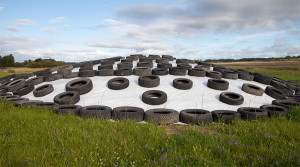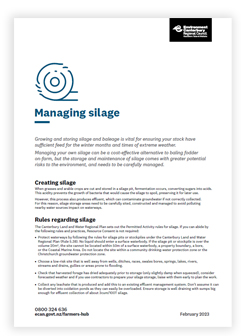Managing silage

Growing and storing silage and baleage is vital for ensuring your stock have sufficient feed for the winter months and times of extreme weather.
Managing your own silage can be a cost-effective alternative to baling fodder on-farm, but the storage and maintenance of silage comes with greater potential risks to the environment, and needs to be carefully managed.
Creating silage
When grasses and arable crops are cut and stored in a silage pit, fermentation occurs, converting sugars into acids. This acidity prevents the growth of bacteria that would cause the silage to spoil, preserving it for later use.
However, this process also produces effluent, which can contaminate groundwater if not correctly collected. For this reason, silage storage areas need to be carefully sited, constructed and managed to avoid polluting nearby water sources.
Rules regarding silage
The Canterbury Land and Water Regional Plan sets out the Permitted Activity rules for silage. If you can abide by the following rules and practices, Resource Consent is not required:
- Protect waterways by following the rules for silage pits or stockpiles under the Canterbury Land and Water Regional Plan (Rule 5.38). No liquid should enter a surface waterbody. If the silage pit or stockpile is over the volume 20m3 , the site cannot be located within 50m of a surface waterbody, a property boundary, a bore, or the Coastal Marine Area. Do not locate the site within a community drinking water protection zone or the Christchurch groundwater protection zone.
- Choose a low-risk site that is well away from wells, ditches, races, swales bores, springs, lakes, rivers, streams and drains, gullies or areas prone to flooding.
- Check that harvested forage has dried adequately prior to storage (only slightly damp when squeezed), consider forecasted weather and if you use contractors to prepare your silage storage, liaise with them early to plan the work.
- Collect any leachate that is produced and add this to an existing effluent management system. Don’t assume it can be diverted into oxidation ponds as they can easily be overloaded. Ensure storage is well draining with sumps big enough for effluent collection of about 3cum/100T silage.
Industry agreed good management practices for silage
The following guidelines have been developed by industry bodies and councils to ensure silage is managed in a way that is most effective and minimises risks to the environment:
- Design feed storage facilities to minimise wastage and soil damage, i.e. sealed or compacted surface.
- Minimise leachate generation (e.g. make silage at optimum moisture content) and prevent leachate from entering surface water bodies, groundwater or stockwater.
- Site silage stacks so that overland flow of water from heavy rain cannot enter the stack.
- Site feed areas away from waterways.
- Distribute feed so as to minimise soil damage (from farm equipment and animals) and potential surface run-off to waterways, i.e. avoid Critical Source Areas.
- Deer: Make sure silage is made at the optimum moisture content to reduce possible leaching, recommended at 30% dry matter or more.
- Outdoor pigs: Feed diets and feed levels appropriate for the physiologic state of the animal i.e. separate gestating and lactating sow diet.
For more information, talk to your industry partners, or see DairyNZ's guidance on storing grass silage.

